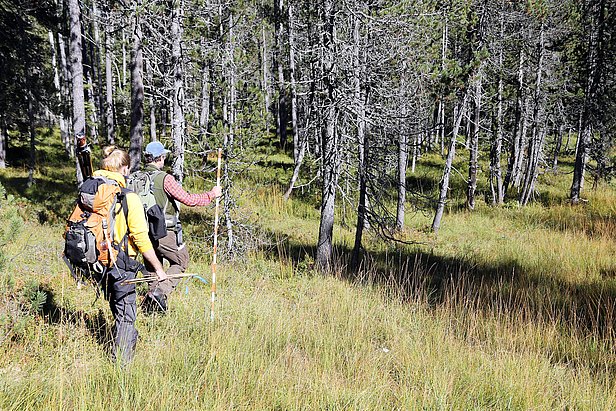Depuis la révision de la loi sur les forêts de 1991, la Confédération a adopté la stratégie «Biodiversité en forêt», dont l’objectif est de promouvoir les réserves forestières naturelles. Nous accompagnons ce développement sur le plan scientifique dans le cadre du projet de coopération «Recherche et contrôle d’efficacité dans les réserves forestières naturelles suisses» porté par le WSL, l’ETH Zurich et l’OFEV, et qui fait lui-même partie depuis 2017 du projet d’observation de l’environnement de la Confédération.
Index ¶
La forêt suisse est exploitée de manière intensive depuis des siècles. Ce qu’il reste des forêts vierges disparaît peu à peu. Depuis la révision de la loi suisse sur les forêts, en 1991, la Confédération soutient la création de réserves forestières naturelles dans le cadre de sa stratégie « biodiversité en forêt ». Ces sites sont en passe de devenir des forêts naturelles et devraient, au fil des décennies, ressembler à nouveau à des forêts vierges.
À la fin de l’année 2018, les réserves forestières naturelles s’étendaient sur 46 199 ha, soit 3,5 % de la surface des forêts en Suisse. Certaines réserves forestières poursuivent d’autres objectifs de protection de la nature, notamment la promotion de certaines essences; ces réserves forestières sont qualifiées de complexes.
La Confédération souhaite connaître l’impact de sa politique en matière de réserves. Comment la forêt se développe-t-elle dans les réserves forestières naturelles? Existe-t-il réellement des différences avec les forêts exploitées? Si oui, lesquelles? Quant aux scientifiques, les réserves forestières naturelles sont pour eux des laboratoires à ciel ouvert uniques qui leur permettent d’étudier le développement des forêts et la biodiversité.
Recherche suisse sur les forêts naturelles ¶
Nous étudions depuis environ 80 ans la dynamique forestière dans un réseau de réserves forestières suisses et dans les forêts primaires des Carpates ukrainiennes. En 2006, nous avons uni nos efforts avec l’ETH Zurich et l’OFEV et lancé un projet de recherche à long terme intitulé «Suivi des réserves forestières naturelles suisses». Une méthode réalisable et standardisée a été développée pour le suivi des forêts naturelles du territoire. Une grande partie des réserves de l’ETH Zurich fait encore l'objet d'un suivi; un certain nombre d’entre elles ont été abandonnées pour permettre l’intégration d’autres réserves qui complètent le programme d’observation de manière opportune. À l’heure actuelle, le suivi est assuré dans 49 réserves qui couvrent les types de végétation présentes en Suisse. Elles sont notamment décrites dans le livre «Waldreservate» (qui n'est plus disponible que via la WSL).
Objectifs de la recherche sur les forêts naturelles ¶
Les objectifs du projet de recherche sont les suivants:
- Surveillance scientifique de l’évolution des forêts au sein d’un réseau de réserves forestières naturelles.
- Analyse des données collectées et publication des résultats.
- Mise à disposition d’indicateurs sur les forêts naturelles pour l’observation de l’environnement de la Confédération.



Contact ¶
Services et produits ¶
Publications de mise en œuvre ¶
Publications scientifiques ¶
Liens ¶
- Groupe de recherche WSL « Dynamique des peuplements et sylviculture »
- Chaire d'écologie forestière (ETH Zurich), en allemand
- OFEV: réserves forestières
- Forêt vierge de Derborence
- Leitsätze einer "Waldreservatspolitik Schweiz" (Fichier PDF en allemand)
- Monitoring de la biodiversité en Suisse
- Base de données des réserves forestières naturelles en Allemagne (en allemand)
- L'Institut bavarois pour la forêt et la sylviculture (LWF) (en allemand)
- NW-FVA Institut de recherche forestière du nord-ouest de l'Allemagne (en allemand)

